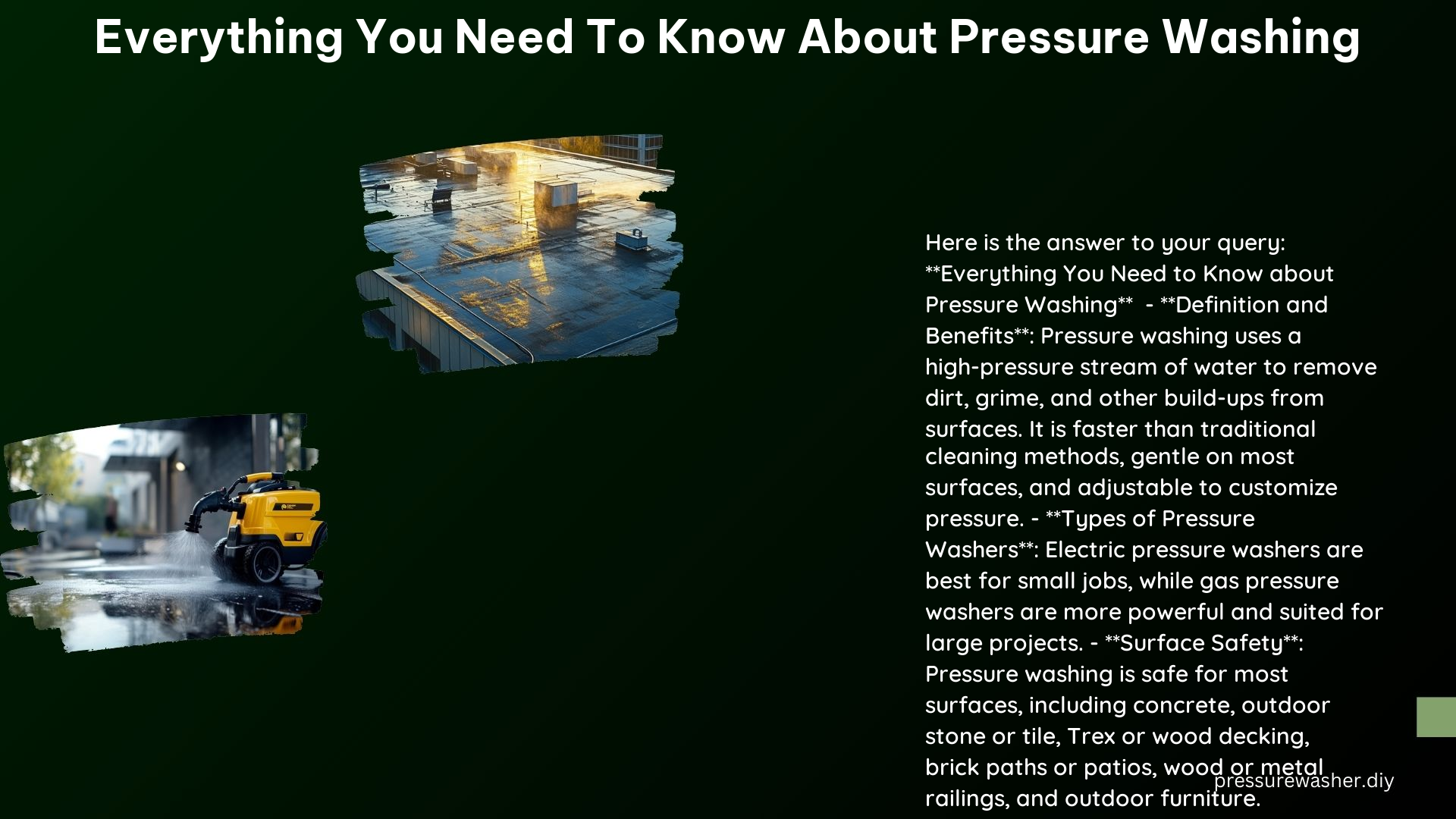Pressure washing is a highly effective method for cleaning various surfaces by removing dirt, grime, mold, and mildew. This comprehensive guide will help you understand the benefits, types of surfaces that can be safely cleaned, and tips for achieving the best results.
Benefits of Pressure Washing
- Efficient Cleaning: Pressure washing can clean up to 3,000 square feet per hour, making it much faster than traditional cleaning methods. It’s ideal for large areas and tough stains that are difficult to remove manually.
- Gentle on Surfaces: Pressure washers use a high-pressure stream of water, typically between 1,300 to 3,100 PSI (pounds per square inch), which is gentle enough not to damage most surfaces, unlike harsh chemicals or abrasive scrubbing.
- Adjustable Pressure: The water pressure can be customized depending on the surface being cleaned, ensuring that delicate surfaces like wood, vinyl, or aluminum siding are not damaged.
- Preparation for Painting or Staining: Pressure washing is an excellent way to prepare surfaces for painting or staining, as it removes any existing dirt, mildew, or chalking paint, ensuring better adhesion and longer-lasting results.
Power Washing vs. Pressure Washing

- Temperature of Water: The main difference between power washing and pressure washing is the temperature of the water. Power washing uses hot water, typically between 180°F to 200°F, while pressure washing uses cold or warm water.
- Effectiveness: Hot water is more effective at removing stubborn stains, such as grease, oil, or built-up grime, while cold water is better for general cleaning of surfaces like concrete, wood, or siding.
- Surface Safety: Pressure washing is less likely to damage surfaces than power washing, especially delicate surfaces like cars, RVs, and boats, as the high-temperature water used in power washing can cause discoloration or warping.
Types of Surfaces That Can Be Safely Pressure Washed
- Concrete: Patios, driveways, and walkways can be safely cleaned with pressure washing, as the high-pressure water can effectively remove dirt, oil stains, and moss buildup.
- Wood: Decks, fences, and siding can be pressure washed, but with caution and the right nozzles to avoid damage. It’s recommended to use a wider, fan-tip nozzle and keep the pressure below 1,500 PSI.
- Metal: Railings, outdoor furniture, and other metal surfaces can be cleaned effectively with pressure washing, as it can remove rust, oxidation, and built-up grime.
- Brick: Brick paths and patios can be pressure washed without causing damage, as the high-pressure water can clean the surface without eroding the mortar.
Tips for Getting the Best Results
- Start with Low Pressure: Begin with the lowest pressure setting, typically around 1,300 PSI, and increase the pressure as needed to avoid damaging the surface.
- Use Pressure Washing Detergent: Specialized detergents are designed to break down dirt and grime, making the cleaning process more manageable. These detergents can be applied before or during the pressure washing process.
- Rinse Before Pressure Washing: Rinse surfaces with a garden hose to remove loose dirt and debris, as this can help the pressure washer work more efficiently.
- Take Your Time: Move the pressure washer slowly across the surface, overlapping each pass to ensure thorough cleaning without causing damage.
Safety Precautions
- Avoid High-Voltage Areas: Keep the pressure washer at least 10 feet away from electrical lines, conduits, and appliances to prevent the risk of electrocution.
- Wear Protective Gear: Use ear and eye protection, closed-toe shoes, and waterproof clothing to prevent injury from the high-pressure water stream.
- Point the Nozzle Away from People and Animals: Ensure the nozzle is directed away from living beings and sensitive materials, as the high-pressure water can cause serious injury or damage.
Technical Specifications
- Pressure Washer Types: Electric pressure washers are suitable for small jobs, with an average pressure range of 1,300 to 1,900 PSI and a flow rate of 1.2 to 1.6 GPM (gallons per minute). Gas pressure washers are more powerful, with a pressure range of 2,000 to 3,100 PSI and a flow rate of 2.3 to 2.8 GPM, making them better suited for large projects.
- Nozzle Selection: Different nozzles are designed for specific surfaces, such as wider tips (40° to 65°) for softer surfaces like wood and shingles, and narrower tips (0° to 25°) for tougher surfaces like concrete or brick.
By understanding the benefits, differences from power washing, and following safety tips and guidelines, you can achieve professional-like results and keep your home or business looking its best with pressure washing.
References:
1. https://www.mitm.com/blog/pressure-washing-ultimate-guide/
2. https://www.younghouselove.com/pressure-washing-101-beginners-guide/
3. https://keepingitcleanmossremoval.com/info-center/helpful-tips/everything-you-need-to-know-about-pressure-washing/
4. https://www.millcitycleaning.com/pressure-washing-101-everything-you-need-to-know-about-this-cleaning-method/
5. https://www.homes.com/blog/things-you-should-know-before-you-power-wash-anything/
